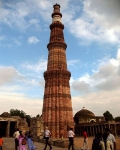Qutub Minar
Archaeology »
Archaeological Monuments » Qutub Minar
Qutub Minar - India
Qutub Minar is located in New Delhi, Delhi.
Qutub Minar monument was established on 1386.
Primary threats to Qutub Minar :
The Qutab Minar is notable for being one of the earliest and most prominent examples of Indo-Islamic architecture.
Historical facts of Qutub Minar :
- Qutub Minar is a towering monument located in Delhi, India, and is one of the most iconic landmarks in the country. It holds great historical significance and represents the rich cultural heritage of India. However, there seems to be some misinformation in your statement that the Qutub Minar was established in 1386. Let me provide you with accurate information about the historical facts of the Qutub Minar.
- The construction of the Qutub Minar began in the early 12th century during the reign of Qutb-ud-din Aibak, the founder of the Delhi Sultanate. Aibak started the construction of the tower as a victory tower to commemorate the Muslim conquest of Delhi. The tower was initially built to a height of around 73 meters, consisting of five stories.
- After the death of Qutb-ud-din Aibak, his successors continued to add more levels to the tower. The second story was added by his son-in-law Iltutmish, who ruled from 1211 to 1236. The third and fourth stories were built by another ruler of the Delhi Sultanate, Firoz Shah Tughlaq, in the 14th century.
- The Qutub Minar is built in a distinctive architectural style known as Indo-Islamic or Mughal architecture. The lower three stories are constructed using red sandstone, while the top two stories are made of marble. Each story of the tower is beautifully decorated with intricate carvings and inscriptions from the Quran.
- One interesting fact about the Qutub Minar is that it is not just a standalone tower but part of a larger complex known as the Qutub Complex. The complex also includes several other historical structures, such as the Quwwat-ul-Islam Mosque, Alai Darwaza, and the Iron Pillar of Delhi.
- The Iron Pillar of Delhi is another remarkable feature within the Qutub Complex. It is a 7-meter-high iron pillar that dates back to the 4th century CE. Despite being exposed to the elements for centuries, the pillar has not rusted and is considered a testament to the advanced metallurgical skills of ancient India.
- Over the centuries, the Qutub Minar has undergone some damage due to natural disasters and human activities. In 1368, a major earthquake caused significant damage to the top two stories of the tower, which were later repaired by Firoz Shah Tughlaq. Restoration work on the Qutub Minar has been carried out by various rulers and organizations throughout history.
- In 1993, the Qutub Minar, along with the Qutub Complex, was designated as a UNESCO World Heritage Site, recognizing its historical and cultural significance. It attracts thousands of visitors every year who come to admire its architectural beauty and learn about India's rich history.
- To summarize, the Qutub Minar is a historical monument that was constructed in the 12th century during the reign of Qutb-ud-din Aibak. It underwent several additions and repairs by subsequent rulers. The tower is a remarkable example of Indo-Islamic architecture and is part of the larger Qutub Complex. Its inclusion in the UNESCO World Heritage list highlights its importance as a cultural and historical treasure of India.

